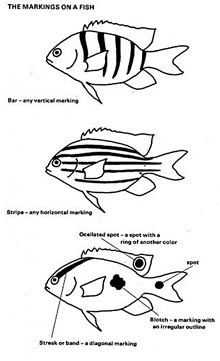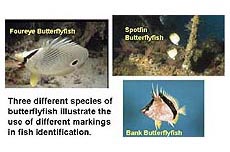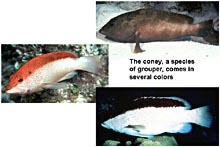
Identifying fish from a submersible, one of the primary tasks of Islands in the Stream 2002, is hardly an easy task. Click image for larger view.
Identifying Fish from the Submersible
August 1, 2002
George Sedberry, Fishery Biologist
South Carolina Department of Natural Resources
Principal Investigator
During Leg 1 of Islands in the Stream 2002, many of the underwater observations and work done by the scientists aboard the submersible Johnson Sea Link II involve identification of fish underwater. This can be a bit more difficult than identifying fish that have been caught and brought to the surface because fish can look very different when they are alive and moving. While living, they are actively swimming around, so you need to use identification characters that can be observed quickly as the fish swims along. Also, living fish may hold their fins differently than they do after the fish is caught. So the length, color and arrangement of the fins on the fish might look quite different in a swimming fish than they do in one that has been caught. Living fish can also rapidly change their colors, which makes color an unreliable characteristic for identification. Thus, because many individual characters of fish change, we must use a combination of characters, such as body shape, patterns of pigment on the body, colors of pigment on the body, and shape and location of the fins.

This black and white drawing shows several of the major characteristics that scientists look for when attempting to identify fish. Click image for larger view.
One useful character in underwater identification of fish is pigment patterns on the skin. Even if the fish has the ability to change color, it will often retain a uniform pattern of spots or stripes, even if the pattern or its background change color. Useful pigment characters include the arrangement of spots, blotches, stripes and bars.
Other useful characters include the shape and placement of the fins. For example, some groupers have rounded tails, some have squared-off tails, and some have tails with extensions at the top or bottom, or in between. Forked or scissor-shaped tails also may be found.
Some of the scientists on this expedition are ichthyologists that have studied the characters useful for fish identification. These experts can identify fishes seen from the submersible, or recorded on videotapes. Other scientists on the cruise use a variety of published identification guides to identify fish. A useful Web site for help in identifying fishes can be found at www.fishbase.org ![]() .
.
Identification of fish will enable us to determine the abundance of fishes of economic value, such as snappers and groupers, and will enable us to evaluate the diversity of fishes at each site. The diversity can be an indicator of the health of the reef, so it is important to correctly identify the fishes seen during submersible dives.
Sign up for the Ocean Explorer E-mail Update List.
















































